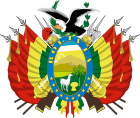| |||||||||||||||||||||||||||||
|
| |||||||||||||||||||||||||||||
Presidential election | |||||||||||||||||||||||||||||
| Registered | 1,871,070 | ||||||||||||||||||||||||||||
|---|---|---|---|---|---|---|---|---|---|---|---|---|---|---|---|---|---|---|---|---|---|---|---|---|---|---|---|---|---|
| Turnout | 90.19% ( | ||||||||||||||||||||||||||||
| |||||||||||||||||||||||||||||
 Results by department | |||||||||||||||||||||||||||||
| |||||||||||||||||||||||||||||
 |
|---|
|
|
General elections were held in Bolivia on 1 July 1979.[2] As no candidate in the presidential elections received a majority of the vote, the National Congress was required to elect a President. However, the Congress failed to elect a candidate after three ballots and instead selected Senate leader Wálter Guevara to serve as Interim President for a year on 8 August.[3] Guevara was later overthrown by a military coup led by Alberto Natusch on 31 October. Fresh elections were held in June 1980.
Although the Democratic and Popular Union received the most votes in the Congressional elections, the Revolutionary Nationalist Movement-Alliance (MNR–A) won the most seats, largely as a result of the electoral system giving more seats to sparsely populated rural areas where the MNR–A was more popular.[4]
Cite error: There are <ref group=lower-alpha> tags or {{efn}} templates on this page, but the references will not show without a {{reflist|group=lower-alpha}} template or {{notelist}} template (see the help page).
- ^ "Corte asignó colores para las elecciones de julio" [Court Assigned Colors for July Elections]. Presencia (in Spanish). La Paz. 28 April 1979. pp. 1, 15.
- ^ Nohlen, Dieter (2005). Elections in the Americas: A data handbook. Vol. II. p. 133. ISBN 978-0-19-928358-3.
- ^ Report on the situation of human rights in the Republic of Bolivia: Chapter IV: Political rights Archived February 1, 2012, at the Wayback Machine OAS
- ^ 1979 IPU


